Omkareshwar Temple
Omkareshwar (IAST: Ōṃkārēśvar) is a Hindu temple dedicated to God Shiva. It is one of the 12 revered Jyotirlinga shrines of Shiva. It is on an island called Mandhata or Shivapuri in the Narmada river at Khandwa District in Madhya Pradesh, India; the shape of the island is said to be like the Devanagari ॐ symbol.
| Omkareshwar Jyothirlinga | |
|---|---|
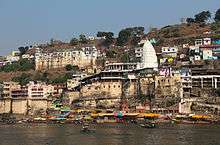 Omkareshwar Mahadev Temple | |
| Religion | |
| Affiliation | Hinduism |
| District | Khandwa |
| Deity | Omkareshwar (Shiva) |
| Location | |
| Location | Madhya Pradesh, India |
| State | Madhya Pradesh |
| Country | India |
 Location in Madhya Pradesh | |
| Geographic coordinates | 22°14′44.1″N 76°09′03.8″E |
| Website | |
| http://www.shriomkareshwar.org/ | |
| Part of a series on |
| Shaivism |
|---|
 |
|
Scriptures and texts
|
|
Philosophy
|
|
Practices |
|
Schools
Saiddhantika Non - Saiddhantika
|
|
Related
|
There are two main temples of Lord Shiva here, one to Omkareshwar (whose name means "Lord of Omkara or the Lord of the Om Sound") located in the island and one to Mamleshwar (whose name means "Immortal lord" or "lord of the Immortals or Devas") located on the south bank of Narmada River on the mainland.
Jyotirlinga
As per Shiv Mahapuran, once Brahma (the Hindu God of creation) and Vishnu (the Hindu God of Protection and Care) had an argument in terms of supremacy of creation.[1] To test them, Shiva pierced the three worlds as a huge endless pillar of light, the jyotirlinga. Vishnu and Brahma split their ways to downwards and upwards respectively to find the end of the light in either directions. Brahma lied that he found out the end, while Vishnu conceded his defeat. Shiva appeared as the second pillar of light and cursed Brahma that he would have no place in ceremonies while Vishnu would be worshipped until the end of eternity. The jyotirlinga is the supreme partless reality, out of which Shiva partly appears. The jyothirlinga shrines, thus are places where Shiva appeared as a fiery column of light.[2][3] Originally there were believed to be 64 jyothirlingas while 12 of them are considered to be very auspicious and holy.[1] Each of the twelve jyothirlinga sites take the name of the presiding deity – each considered different manifestation of Shiva.[4] At all these sites, the primary image is lingam representing the beginningless and endless Stambha pillar, symbolizing the infinite nature of Shiva.[4][5][6]
The twelve jyothirlingas are Somnath in Gujarat, Mallikarjuna at Srisailam in Andhra Pradesh, Mahakaleswar at Ujjain in Madhya Pradesh, Omkareshwar in Khandwa in Madhya Pradesh, Kedarnath in Himalayas, in Uttrakhand state, Bhimashankar in Maharashtra, Viswanath at Varanasi in Uttar Pradesh, Triambakeshwar near Nashik in Maharashtra, Baidyanath Temple, Deogarh in Jharkhand, Nageswar at Dwarka in Gujarat, Rameshwar at Rameswaram in Tamil Nadu and Grishneshwar near Aurangabad, Maharashtra in Maharashtra.[1][7]
Legends and history
As per Hindu legend, Vindya, the deity controlling the Vindyachal mountain range was worshipping Shiva to propitiate himself from the sins committed. He created a sacred geometrical diagram and a Lingam made of sand and clay. Shiva was pleased with the worship and believed to have appeared in two forms, namely Omkareshwar and Amaleswara. Since the mud mound appeared in the form of Om, the island came to be known as Omkareswar. There is a shrine for Parvati and Ganapati in the temple.[8]
The second story relates to Mandhata and his son's penance. King Mandhata of Ikshvaku clan (an ancestor of Lord Ram) worshipped Lord Shiva here until the Lord manifested himself as a Jyotirlinga. Some scholars also narrate the story about Mandhata's sons-Ambarish and Muchukunda, who had practiced severe penance and austerities here and pleased Lord Shiva. Because of this, the mountain is named Mandhata.
The third story from Hindu scriptures says that once upon a time there was a great war between Devas (gods) and Danavas (demons), in which Danavas won. This was a major setback for Devas and hence Devas prayed to Lord Shiva. Pleased with their prayer, Lord Shiva emerged in the form of Omkareshwar Jyotirlinga and defeated Danavas.
Philosophy of Omkaar - Advait Matt says Omkaar is composed of two words, Om (sound) and Akaar (srishti). Both are one not two since Advait means "not two". Om beez mantra of Srishti, itself is creator of Srishti.
Adi Shankara's Cave – Omkareshwar is said to be the place where Adi Sankara met his guru Govindapada in a cave. This cave can be found even today just below the Shiva temple where an image of Adi Shankara has been installed.[9]
Location
It is situated in the Khandwa district of Madhya Pradesh state in India. It is about 12 km from Mortakka in Madhya Pradesh. Omkareshwar is formed by the sacred river Narmada. This is one of the most sacred rivers in India and is now home to one of the world's biggest dam projects. The temple is situated on Mandatha island on the banks of Narmada and river Kaveri (a tributary of Narmada). The island is 2.6 km2 (2,600,000 m2) in area and can be approached by boats and bridge.[8]
Gallery

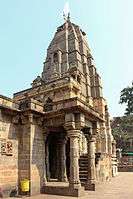 Mamleshwar Temple
Mamleshwar Temple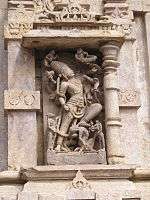 Sculpture at Mamleshwar Temple
Sculpture at Mamleshwar Temple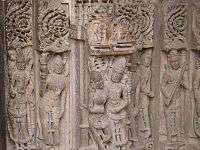 Sculpture at Omkareshwar Temple
Sculpture at Omkareshwar Temple- Mamleshwar Jyotirlinga
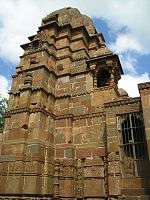 One of the temple shrines
One of the temple shrines Omkareshwar Palace
Omkareshwar Palace Gomukh ghat
Gomukh ghat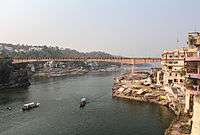 View of Narmada
View of Narmada Omkareshwar temple view
Omkareshwar temple view
References
- R. 2003, pp. 92-95
- Eck 1999, p. 107
- See: Gwynne 2008, Section on Char Dham
- Lochtefeld 2002, pp. 324-325
- Harding 1998, pp. 158-158
- Vivekananda Vol. 4
- Chaturvedi 2006, pp. 58-72
- Harshananda, Swami (2012). Hindu Pilgrim centres (2nd ed.). Bangalore, India: Ramakrishna Math. pp. 98–100. ISBN 81-7907-053-0.
- http://www.columbuslost.com/2015/03/omkareshwar-narmada-yatra.html
Notes
- Chaturvedi, Jyoti. (2006), Shiv Purana (First ed.), New Delhi: Diamond Pocket Books (P) Ltd, ISBN 81-7182-721-7
- Eck, Diana L. (1999), Banaras, city of light (First ed.), New York: Columbia University Press, ISBN 0-231-11447-8
- Gwynne, Paul (2009), World Religions in Practice: A Comparative Introduction, Oxford: Blackwell Publication, ISBN 978-1-4051-6702-4.
- Harding, Elizabeth U. (1998). "God, the Father". Kali: The Black Goddess of Dakshineswar. Motilal Banarsidass. pp. 156–157. ISBN 978-81-208-1450-9.
- Lochtefeld, James G. (2002), The Illustrated Encyclopedia of Hinduism: A-M, Rosen Publishing Group, p. 122, ISBN 0-8239-3179-X
- R., Venugopalam (2003), Meditation: Any Time Any Where (First ed.), Delhi: B. Jain Publishers (P) Ltd., ISBN 81-8056-373-1
- Vivekananda, Swami. "The Paris Congress of the History of Religions". The Complete Works of Swami Vivekananda. 4.
External links
| Wikimedia Commons has media related to Omkareshwar Temple. |
